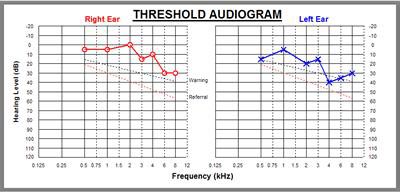| |
Audiometry

Pure tone audiometry
(PTA) is the key hearing test used to identify hearing
threshold levels of an individual, enabling determination
of the degree, type and configuration of a hearing
loss. Thus, providing the basis for diagnosis and
management. PTA is a subjective, behavioral measurement
of hearing threshold, as it relies on patient response
to pure tone stimuli. Therefore, PTA is used on adults
and children old enough to cooperate with the test
procedure.

PTA only measures thresholds, rather
than other aspects of hearing such as sound localization.
However, there are benefits of using PTA over other
forms of hearing test, such as click auditory brainstem
response. PTA provides ear specific thresholds, and
uses frequency specific pure tones to give place specific
responses, so that the configuration of a hearing
loss can be identified. As PTA uses both air and bone
conduction audiometry, the type of loss can also be
identified via the air-bone gap. Although PTA has
many clinical benefits, it is not perfect at identifying
all losses.
Pure tone audiometry (PTA) is the key hearing test
used to identify hearing threshold levels of an individual,
enabling determination of the degree, type and configuration
of a hearing loss. Thus, providing the basis for diagnosis
and management. PTA is a subjective, behavioral measurement
of hearing threshold, as it relies on patient response
to pure tone stimuli. Therefore, PTA is used on adults
and children old enough to cooperate with the test
procedure.
PTA only measures thresholds, rather than other aspects
of hearing such as sound localization. However, there
are benefits of using PTA over other forms of hearing
test, such as click auditory brainstem response. PTA
provides ear specific thresholds, and uses frequency
specific pure tones to give place specific responses,
so that the configuration of a hearing loss can be
identified. As PTA uses both air and bone conduction
audiometry, the type of loss can also be identified
via the air-bone gap. Although PTA has many clinical
benefits, it is not perfect at identifying all losses.
Pure tone audiometry (PTA) is the key hearing test
used to identify hearing threshold levels of an individual,
enabling determination of the degree, type and configuration
of a hearing loss. Thus, providing the basis for diagnosis
and management. PTA is a subjective, behavioral measurement
of hearing threshold, as it relies on patient response
to pure tone stimuli. Therefore, PTA is used on adults
and children old enough to cooperate with the test
procedure.
PTA only measures thresholds, rather than other aspects
of hearing such as sound localization. However, there
are benefits of using PTA over other forms of hearing
test, such as click auditory brainstem response. PTA
provides ear specific thresholds, and uses frequency
specific pure tones to give place specific responses,
so that the configuration of a hearing loss can be
identified. As PTA uses both air and bone conduction
audiometry, the type of loss can also be identified
via the air-bone gap. Although PTA has many clinical
benefits, it is not perfect at identifying all losses.
|